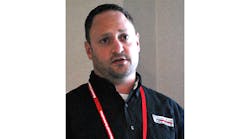The batch management system on The Scotts Miracle-Go Company’s lawn products bagging and palletizing lines in Marysville, Ohio, couldn’t be modified or updated without calling in a system integrator. It couldn’t be expanded, it was becoming unreliable, and it ran on obsolete Windows XP.
The facility had standardized on Allen-Bradley equipment, and it made sense to look at Rockwell Automation software for a replacement. “By leveraging the FactoryTalk software suite for fast and accurate product reporting, Scotts gained a common interface and easy-to-understand, real-time view into product weight, throughput and quality metrics,” Dustin Wilson, technical lead, Phantom Technical Services, Columbus, Ohio, told attendees of his session at Rockwell Automation TechED 2015 in San Diego. “They can also now easily retrieve years of historical records for regulatory compliance.”
The monitored equipment on each line includes a checkweigher, a palletizer and a shared trunkline that conveys pallets to wrapping and labeling. Data is used to establish process rates and weighing accuracy, measure OEE and track production lots.
They also upgraded the server hardware to handle virtualization, make the operating system compliant, and more secure and reliable data storage. The open-source solution allows internal modifications, improved recipe management, visibility into production metrics and fault tracking. The upgrade required special attention to the network and server structure to allow virtualization, application load balancing and reports available on multiple enterprise networks, as well as integration with the Mettler Toledo checkweigher. It relies on a combination of software including FactoryTalk VantagePoint, Metrics and Transaction Manager.
A plant model was created in FactoryTalk VantagePoint to allow easy user navigation, with a single user portal to see all production-related data including live Xcelsius graphics, ReportExport Metrics data, custom SSRS reports, and in the future, historian trends.
“To build the screens, we used an HTML web container with VantagePoint composite reports, Excelcius live graphics and SRSS reports,” said Wilson. “We wanted the operator interface to have a traditional look and feel, so we used an HTML page.”
Users can navigate from production to, for example, lab results in the same view.
The application combines FactoryTalk VantagePoint and Xcelsius graphics data in the same HTML view. “Data that’s seldom changed, like batch type, is updated slowly—every 15 seconds,” said Wilson. “That allows us to refresh the fast data, like bagging rates, every second.”
The displays at the checkweigher have live graphics that give operators real-time data to make production-related decisions. “At a glance, operators can tell if production is within tolerance,” Wilson said. “Color bars let them see at a distance how things are running. Close up, trend charts show them what they might need to adjust.”
Different tabs break down the production run by shift. “They can see how well the shift ran, and the percentage outside the ideal spec weight. They can drill down to see individual bags, look at trends over the entire run, or compare it to historical data,” Wilson said. “We made sure to include the actual cycle time and the ideal cycle time, which is held in the recipe manager and downloaded so they can see it, and we can calculate OEE.”
By leveraging the FactoryTalk software suite for fast and accurate product reporting, Scotts gained a common interface and easy-to-understand, real-time view into product weight, throughput and quality metrics
— Dustin Wilson, technical lead, Phantom Technical Services, Columbus, Ohio
More than 200 user-defined events are categorized by work cell, and there are six or seven states per work cell, as well as six overall line states. Configured SSRS reports allow data to be displayed, calculated, and refreshed, and ReportExpert built-in reports provide data “right out of the box,” Wilson said. ”Default parameter sets are a quick way to group data, and custom parameter sets allow the user to drill into data as needed.”
Dashboards give an overview of production, tiled in groups that make them easy to read. Individual tiles show OEE; OEE components (uptime, throughput, quality); production and fault summaries; good vs. scrap parts; and machine states.
“The dashboards are good for production and shift turnover meetings because they report how the line ran for the past 24 hours—your performance vs. goal,” said Matt Ackerman, controls engineer, The Scotts Company.
Bar graphs track production rates by the hour. “Say your target is 5,280 bags per shift,” he said. “If you’re at 80% or better, it’s green. At 60-80%, its yellow, and anything below that is red. The bar graphs let you see at a glance where problems occurred. You can dive down into scrap, OEE, availability, quality—all of that is available very easily.”
Ackerman summarized the benefits of the project for Scotts:
• All portions of the system are open source and editable as needed, when needed.
• Live data allows on-the-fly adjustments: “Operators can see how well they’re doing, and adjust the scales or baggers to stay on spec. We have fewer rejects, and fewer overfills, which adds up to significant savings.”
• New recipe functions reduce change-over time: “The recipes reduce changeover time. They used to be on a central computer, pushed line-by-line. Now it only takes about three pushes and it’s ready.”
• Metrics provide real-time production information: “The bar graph on the checkweigher scrolls and updates in real time so operations can see trends and make corrections. They can see from far away how well they’re doing, with continuous updates of bags-per-minute rate and OEE.”
• Future expansion gives the ability to add FactoryTalk Historian for an all-in-one portal.
“You can see where to add new capabilities or modify existing equipment,” Acherman said. “Together, the improvements have raised our expectations from 14 to 16-17 bags per minute—that’s around 10%. Today, we’re on 10 checkweigh lines, and we’ll be applying it to nine packaging lines. Meanwhile, we’re able to really start hammering on where to make improvements.”
This article was originally published on ControlGlobal.com.




